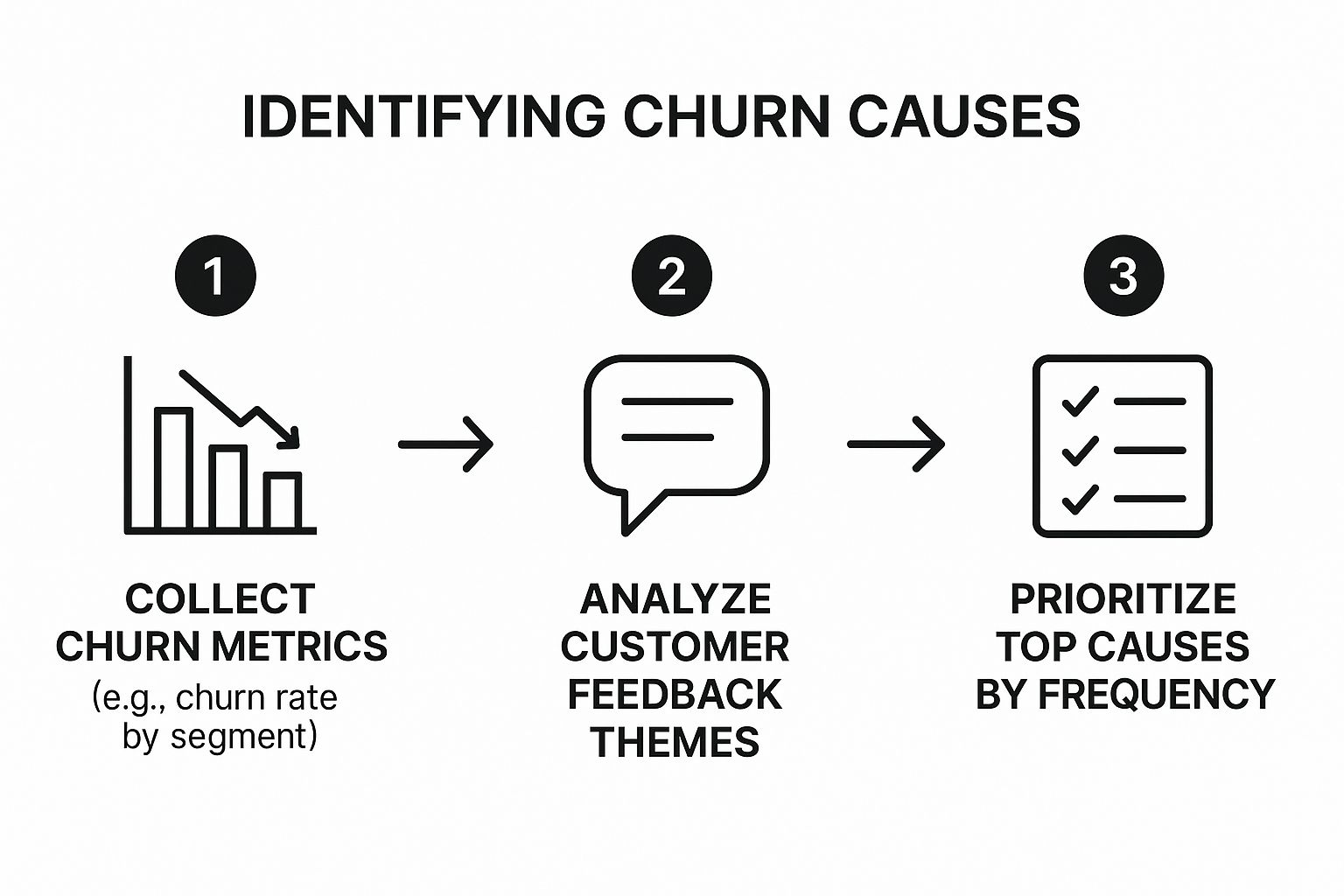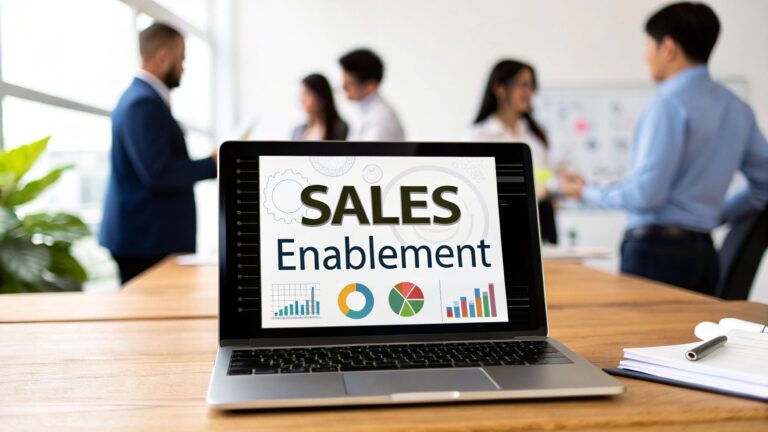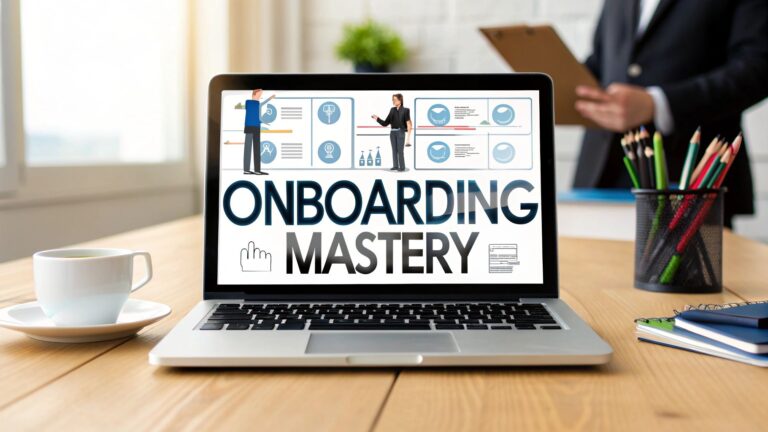How to Reduce Customer Churn: Proven Strategies to Boost Retention
If you want sustainable growth, you can't afford to ignore customer churn. It’s all about creating a better customer experience and stepping in to help at-risk accounts before they think about leaving. This means digging into why customers are walking away, perfecting your onboarding process, and building a system that encourages real, long-term loyalty.
Why Customer Retention Is Your Strongest Growth Engine
Before we get into the nuts and bolts of how to reduce churn, let's talk about why it's the most powerful lever you can pull for business growth. So many companies fall into the "leaky bucket" trap. They pour a ton of time and money into getting new customers, only to watch their existing ones quietly disappear out the back door. This isn't just a small drip; it's a massive financial drain.
The numbers don't lie. U.S. businesses lose a staggering $136.8 billion every year from customer churn that could have been prevented. What's the main culprit? A poor customer experience. In fact, 67% of consumers will jump ship to a competitor after just one bad interaction. This makes one thing crystal clear: retention isn't something that just happens. It's an active strategy you have to build. You can find more eye-opening customer retention statistics and insights on Sprinklr.com.
Shifting from Defense to Offense
It’s a huge mistake to think of retention as just a defensive game—simply trying to stop the bleeding. In reality, it’s one of the best offensive plays you can make. Your loyal customers are the foundation of predictable revenue, and their value grows exponentially over time.
Here's why putting retention first pays off big time:
- It’s Cheaper: We've all heard it, but it’s true. Getting a new customer can cost five times more than keeping an existing one. Focusing on retention directly boosts your profitability by making your acquisition dollars go further.
- It Increases Customer Lifetime Value (CLV): Customers who stick around also tend to spend more. They're far more likely to upgrade, add new services, and become more deeply invested in what you offer.
- It Creates Powerful Social Proof: Your happiest customers are your best marketers, hands down. They leave amazing testimonials, write glowing reviews, and, most importantly, send high-quality referrals your way. This creates a growth loop that practically runs itself.
The True Cost of Neglecting Churn
When you lose a customer, you lose so much more than their monthly subscription. You lose all their future revenue, any upsell opportunities, and a priceless source of honest feedback.
Every customer who churns has a story—a moment where your product, your service, or your communication just didn't hit the mark. The first step toward building a more durable business is taking the time to understand those stories.
At its heart, a great retention strategy is about making your customers feel so successful and valued that leaving isn't even on their radar. You're moving the relationship from a simple transaction to a true partnership.
Ultimately, figuring out how to reduce churn isn’t just about patching holes. It’s about building a stronger, more profitable, and genuinely customer-focused company. When you nail the strategies that keep customers happy and engaged, you create a powerful engine for success that will last.
For SaaS businesses, in particular, this is a critical topic. You can explore these ideas more thoroughly in our complete guide to SaaS customer retention strategies.
Uncovering the Real Reasons Your Customers Leave
You can't fix a problem you don't understand. To actually make a dent in your churn rate, you have to get past the assumptions and dig into the real, often uncomfortable, reasons customers decide to leave. It's almost never just one thing; it's usually a series of friction points that slowly chip away at their loyalty.
Think of yourself as a detective. Your first job is to stop guessing and start diagnosing with hard evidence. This means blending quantitative data with qualitative feedback to build a complete picture of where your customer experience is falling short.
Mine Your Existing Feedback Channels
Your customers are already telling you what's wrong—you just have to listen. Support tickets, live chat transcripts, and online reviews are absolute goldmines of raw, unfiltered feedback. Stop treating them as one-off problems to be solved and start seeing them as a collective dataset.
Look for patterns and recurring keywords. Are people constantly complaining about a specific feature being buggy? Does the phrase "hard to use" keep popping up? These trends are your starting point. One person complaining is an anecdote; 20 people complaining about the same thing is a systemic issue that's almost certainly costing you customers.
This is all about moving from raw data to real, actionable priorities.

As you can see, the secret isn't just gathering data. It's about systematically analyzing and prioritizing it so you can focus your efforts where they'll have the biggest impact on retention.
Analyze Customer Behavior Data
While feedback tells you what customers say, their behavior shows you what they actually do (or don't do). A sudden drop in product usage is one of the most reliable leading indicators of churn. If a user who was logging in daily hasn't been seen in two weeks, the alarm bells should be ringing.
Dive into your product analytics and look for these tell-tale signs:
- Poor Feature Adoption: Are new users ignoring the key features that deliver your core value? That’s a classic sign of a broken or confusing onboarding process.
- Declining Usage Frequency: Has a customer’s activity dropped from daily to weekly, or from weekly to monthly? This is a slow fade that often ends in cancellation.
- Spike in Support Tickets: A sudden increase in support requests from one account can signal deep frustration that comes right before they give up.
To get to the root of these behaviors, it’s worth applying more rigorous analytical methods. Advanced techniques like causal inference machine learning can help you move beyond simple correlations to pinpoint the specific actions or events that truly cause churn, giving you a much clearer path to an effective solution.
Conduct Meaningful Exit Interviews
When a customer finally clicks that "cancel" button, you have one last, best chance to get brutally honest feedback. Don't waste it. A generic, automated email is better than nothing, but a personal touch—like a quick phone call or a simple, open-ended exit survey—can provide priceless insights.
The key is to ask open-ended questions. Instead of, "Was our pricing too high?" which leads the witness, ask, "What was the primary reason you decided to move on?" You’ll get a much more detailed and truthful answer.
The goal of an exit interview isn't to win that customer back right then and there. It's to learn a lesson that will help you keep the next ten customers from ever reaching that point.
Treat every bit of feedback from a churning customer as a gift. They have zero reason to be anything but direct, and that honesty is exactly what you need to improve.
Mapping Churn Drivers to Customer Segments
Not all customers leave for the same reasons. A startup founder might churn because your pricing scaled too quickly for them, while an enterprise user might leave because you lack a key security feature. This is why segmenting your churn data is so critical for prioritizing your response.
You need a clear framework that connects the "why" (the churn driver) with the "who" (the customer segment). This simple exercise can reveal if a particular problem is disproportionately hurting a specific group.
Mapping Churn Drivers to Customer Segments
This table offers a straightforward way to organize your findings. By mapping churn reasons to the customer segments they affect most, you can start to see where your biggest fires are and direct your resources accordingly.
| Churn Driver | Affected Customer Segment(s) | Data Source for Diagnosis | Potential Solution Category |
|---|---|---|---|
| Poor Onboarding | Small Businesses, Free Trial Users | Low feature adoption rates, Exit surveys | In-app guides, Onboarding emails |
| Missing Key Features | Mid-Market, Enterprise Clients | Canceled subscription reasons, Sales feedback | Product roadmap prioritization |
| Pricing/Value Mismatch | Startups, Solo Entrepreneurs | Exit interviews, Competitor analysis | New pricing tiers, Annual discounts |
| Technical Bugs/Performance | Power Users, Long-term Customers | Support ticket volume, In-app feedback | Engineering resource allocation |
This kind of analysis provides clarity. For instance, you might discover that 70% of churn from small businesses is tied to a confusing onboarding experience. Suddenly, you know exactly where to focus your product and marketing teams to have the most immediate impact.
Designing an Unforgettable Onboarding Experience
The battle against churn is often won or lost in the first few days. Think about it: a clunky, confusing, or just plain underwhelming onboarding experience is a direct flight to the cancellation page. When new users feel lost or don't immediately see the value you promised them, their excitement fizzles out. Fast.
Your one and only goal during onboarding is to get every new user to their "aha!" moment as quickly and painlessly as possible. This isn't just a buzzword; it's that magic point where they truly get how your product solves their problem. It's not about throwing every feature at them at once. It’s about guiding them to a quick, meaningful win.

Personalize the Welcome from Day One
The second a customer signs up is your golden opportunity to make them feel understood. A generic "Welcome!" email just doesn't cut it anymore. Use the information you gathered during sign-up to tailor that very first interaction.
For example, if someone signs up and identifies their role as a "Sales Manager," your welcome email shouldn't just use their name. It should immediately point them to features that sales teams love, like your CRM integration or lead tracking dashboards. This small step shows you're already thinking about their specific needs.
Ditch the Passive Tour for Guided, In-App Learning
Let's be honest, we've all mindlessly clicked "next, next, next" through a product tour just to get it over with, retaining absolutely nothing. Those passive, one-size-fits-all tours are dead. The real key is making the learning interactive and context-aware.
Instead of one long, front-loaded tour, sprinkle in tooltips and small, guided prompts as users navigate your app. When they land on the analytics page for the first time, a prompt could pop up: "Ready to build your first report? Let’s start by selecting a date range here." This approach teaches people by having them do the thing, which is infinitely more powerful.
I've seen it time and again: a great onboarding experience doesn't just show users what your features are; it shows them why those features matter to them. It connects your product's functions to their personal goals.
Proactively Check In (with a Real Human)
Automation is your best friend for scaling, I get it. But during that critical first week, a genuine human touch can be the single most powerful tool you have to prevent early churn. A proactive check-in from a customer success manager is worth its weight in gold.
This doesn't need to be a long, drawn-out call. A simple, personalized email can work wonders.
Something like:
"Hi [Name], I'm [Your Name] from the success team here at [Company]. I saw you just set up your first project—awesome! I’ve found that most folks in your shoes find our [Specific Feature] really helps them hit [Goal]. Do you have 15 minutes next week for a quick chat? I'd love to make sure you're getting the most value right from the start."
An email like this pulls off three things beautifully:
- It shows you're paying attention and are personally invested in their success.
- It offers specific, practical advice that helps them clear a potential hurdle.
- It opens a direct line of communication, making them far more likely to ask for help later.
By setting customers up for a win right out of the gate, you build their confidence and prove your product's value. This foundational experience is what turns new sign-ups into loyal advocates. For a much deeper dive into structuring this critical process, our guide on https://makeautomation.co/client-onboarding-best-practices/ provides a complete framework you can put into action.
Building a Proactive Feedback and Engagement System
Figuring out why customers churn is essential, but it's a reactive game. You're always looking in the rearview mirror. The real breakthrough happens when you shift your focus from analyzing why people left to creating an environment where they genuinely want to stay. This means building a system for constantly listening and engaging—turning a monologue into a real conversation.
This isn't about blasting out a single, massive survey once a year and ticking a box. It's about weaving consistent, meaningful touchpoints into the entire customer journey. The goal? To make your customers feel seen, heard, and valued, transforming a purely transactional relationship into a true partnership.

Go Beyond the Annual Survey
Traditional surveys have a fundamental flaw: timing. By the time you’ve collected and analyzed the results, the feedback is already stale. Worse, the customer who gave it might have already churned. A proactive feedback system, on the other hand, captures insights in the moments that actually matter.
Instead of a broad, one-size-fits-all approach, start deploying targeted, event-triggered feedback requests. Think smaller, and think contextual.
- Post-Support Interaction: The second a support ticket is closed, pop a simple one-question survey their way: "How did we do?" This gives you an immediate pulse on the quality of your customer service.
- After a New Feature Launch: Ping users who've actually tried a new feature and ask for their honest thoughts. Not only do you get valuable product feedback, but you also make those users feel like they're co-creating the product with you.
- Following a Milestone: When a customer hits their one-year anniversary, don't just let it pass. Celebrate it with them, and then ask what you could do to make their second year even better.
These small, in-the-moment check-ins are so much more effective than a long, daunting annual survey. You'll get a steady stream of actionable data while showing customers you're paying attention to their specific experience.
Use NPS as a Conversation Starter, Not a Vanity Metric
The Net Promoter Score (NPS) is everywhere, but most companies get it wrong. They fixate on the score itself. Knowing you have an NPS of 45 is interesting, but it doesn't tell you a single thing about how to stop customers from leaving. The gold is in the follow-up.
An NPS score tells you the 'what.' The open-ended comments that follow tell you the 'why.' That 'why' is where your entire retention strategy lives. Don't just collect scores; start conversations based on them.
Segment your NPS responses and create a systematic plan to "close the loop" with each group.
- Promoters (Score 9-10): Thank them like they're rockstars. Ask them if they'd be willing to share their experience in a review or join a case study. These are your champions—give them a megaphone.
- Passives (Score 7-8): These customers are on the fence. Reach out and ask, "What’s the one thing we could do to turn your experience into a 10?" Their feedback is often the most practical, pointing to the small tweaks that make a big difference.
- Detractors (Score 0-6): This is your code-red moment. A senior team member needs to personally contact them, ideally within 24 hours, to truly understand their frustration and work to make it right.
When you act on feedback, you prove that you're not just collecting data for a spreadsheet—you're listening. That simple act can turn an angry detractor into one of your most loyal advocates.
Drive Engagement with Personalized Communication
Feedback is only half the battle; proactive engagement is the other. This is all about communicating with customers before they have a problem, using personalization to make every interaction feel relevant and valuable.
This is especially critical when you realize churn challenges look very different from one industry to the next. In competitive markets, frequent, personalized touchpoints are often the secret to preventing churn before it even starts. The financial motivation is massive—customers with positive experiences spend 140% more than those who had a bad one. To dig deeper, check out these industry-specific churn benchmarks and insights.
Try weaving these engagement tactics into your strategy:
- Share Hyper-Relevant Content: If a customer lives in your project management module, send them an advanced guide on workflow optimization. Ditch the generic newsletter and give them content that directly helps them succeed.
- Celebrate Their Wins: Did a customer just hit a huge usage milestone or achieve a major goal with your product? Acknowledge it! A quick, personalized "congrats" shows you're invested in their success, not just their renewal.
- Offer Proactive Success Check-Ins: For your high-value accounts, get quarterly check-ins on the calendar. Use that time to review their goals, demo new features that would benefit them, and make sure they're squeezing every drop of value out of your platform.
In the end, a proactive feedback and engagement system is about fostering a partnership. When customers feel like you're actively on their team, they stop seeing you as a disposable tool and start seeing you as an indispensable part of their own success. That's when they stick around.
Using Predictive Analytics to Get Ahead of Churn
Imagine knowing a customer is on the verge of leaving before they’ve even decided for themselves. That’s not a superpower—it’s the reality of predictive analytics. When you stop scrambling to "save the account" after the fact and start getting ahead of problems, you can address issues while they're still small enough to solve.
This is about moving beyond simple dashboards. It requires using AI and machine learning to read the subtle signals hidden in your customer data. Your CRM and product usage logs are packed with clues: login frequency, feature adoption rates, the volume of support tickets, and even how promptly invoices are paid. On their own, these data points might not raise any alarms, but together, they paint a crystal-clear picture of customer health.

Identifying the Right Churn Signals
The first thing to figure out is what to actually look for. Not all data is equally important, and the red flags for one business might be completely irrelevant to another. The real trick is connecting specific user behaviors to whether they're getting real value from your product.
A good starting point is to analyze your most successful, long-term customers. What do they do? Which features do they use? Once you identify those patterns of success, you can build a model that flags accounts when they start to drift away from that ideal behavior.
Here are some of the most reliable signals I've seen:
- Declining Product Engagement: This is the classic. A customer who used to log in every day but now only pops in once a week is sending a loud and clear message.
- Reduced Feature Adoption: Are they ignoring the key features that deliver the most value? If someone has been with you for six months but has never touched your most powerful module, it's a safe bet they don't see the full value in your service.
- Surge in Support Tickets: A sudden spike in support requests, especially about core functionality or performance issues, often signals deep frustration that comes right before churn.
- Organizational Changes: This is a big one people miss. If your main champion or primary user leaves their company, that account is immediately at risk. Keeping an eye on these personnel shifts is crucial.
Building a Customer Health Score
Once you know which signals matter, you can roll them up into a single, dynamic metric: a customer health score. Think of it as a live pulse check that gives you an at-a-glance understanding of which accounts are thriving and which are in trouble.
This isn't just a simple "good" or "bad" label. It should be a weighted score that tells you who needs attention right now. For instance, a single missed payment might dock their score by 5 points, but a 30-day gap in logins could knock it down by 20 points. By quantifying the risk, you empower your customer success team to stop guessing and start prioritizing their efforts on high-value accounts showing the earliest signs of trouble.
If you want to dig deeper into the fundamentals, our guide explains what predictive analytics is and how it works.
Predictive analytics transforms retention from guesswork into a data-driven science. Instead of waiting for a cancellation email to land in your inbox, you’re proactively reaching out with the right help at the right time—often before the customer even realizes they need it.
Automating Proactive Interventions
Spotting at-risk customers is only half the job. The real magic happens when you build automated workflows that trigger interventions based on changes in their health score. This is where you can truly move the needle on reducing churn.
A smart automation can instantly alert the right team member or deliver a perfectly timed message the moment a risk factor appears. This ensures no struggling customer ever slips through the cracks.
Think about setting up plays like these:
- Low Engagement Trigger: If a user’s activity drops by 50% in a week, automatically send an email from their customer success manager with a helpful tip or a new case study relevant to their business.
- Failed Integration Alert: When an API integration fails, don't just log an error in the backend. Automatically create a high-priority support ticket and notify the account manager to reach out and offer help.
- High-Value Account Risk: If a top-tier account's health score dips into the "at-risk" zone, automatically schedule an internal alert for the Head of Customer Success to personally review the account.
This kind of proactive management is especially potent in the SaaS world. The average churn rate for B2B SaaS companies is around 3.5%—a relatively low figure that shows just how much the industry prioritizes retention. In fact, recent data shows that SaaS businesses have not only cut churn by 3.3% but have also seen a 7% drop in downgrades. This highlights how critical proactive strategies are for sustainable growth. By getting ahead of churn with predictive analytics, you can build on that success and forge an even more resilient customer base.
Common Questions About Reducing Customer Churn
Even when you're deep in the weeds of retention strategies, some questions just keep coming up. Churn is a slippery problem, and the right move isn't always clear. Let's tackle some of the most common questions I hear from founders and managers to help you cut through the noise and act with more confidence.
How Do I Calculate My Customer Churn Rate Accurately?
Calculating churn can feel more complicated than it needs to be. The most important thing? Be consistent.
The basic formula is pretty simple: (Number of Customers Who Left in a Period / Total Customers at the Start of the Period) x 100. So, if you started the month with 500 customers and 25 left, your monthly churn rate is 5%.
The real trick is defining what "a customer who left" actually means. Is it someone who canceled their subscription? Or someone who let their contract expire? You need to decide on a firm definition for your business and stick to it. Once you have that, you can slice the data by customer cohorts, pricing plans, or even how they found you to get some really powerful insights.
What Is the First and Most Important Step to Reduce Churn?
Before you dive into predictive analytics or overhauling your onboarding, do this one thing first: talk to the customers who just left. Seriously. They hold the most brutally honest and valuable feedback you will ever get about where your product or service is falling short.
This doesn't have to be a massive project. A quick exit interview or even a single-question survey that asks, "What was the main reason you decided to cancel?" can be incredibly revealing. This is pure gold for figuring out the root causes of your churn and deciding what you need to fix right now.
Is There Such a Thing as Good Churn?
It sounds counterintuitive, but yes. Not all churn is bad. In fact, some of it is healthy for your business. We call this "good churn," and it happens when you lose customers who were a terrible fit from the start.
Think about the customers who drain your support team's time and energy. They might be:
- Misusing the product: They're trying to hammer a screw, then complaining your tool isn't a good hammer.
- Unprofitable to serve: Their support tickets and demands cost you far more than their subscription is worth.
- A poor value match: They signed up to solve a problem that your product doesn't actually address.
Letting these customers go is a strategic move. It frees up your team to focus on your ideal customers—the ones who truly get value, stick around, and become your best advocates.
Churning a bad-fit customer isn't a failure. It's a strategic decision that frees up your team to better serve the customers who truly belong with you, ultimately strengthening your business.
How Long Does It Take to See Results From Retention Efforts?
This really depends on what you're doing. Some fixes can produce results almost immediately, while others are more of a long game.
For example, improving your support response times or making a compelling "save" offer when someone tries to cancel can make a difference in the very same month. But for the big, foundational changes—like redesigning your entire onboarding flow or building a predictive churn model—you need to be more patient. Those are bigger investments, and you're likely looking at 3-6 months before you see a significant, lasting drop in your churn rate.
Ready to turn churn insights into automated action? The team at MakeAutomation specializes in building the AI and automation workflows that proactively engage at-risk customers and scale your retention efforts. Book a consultation with MakeAutomation to see how we can help you build a more resilient customer base.







